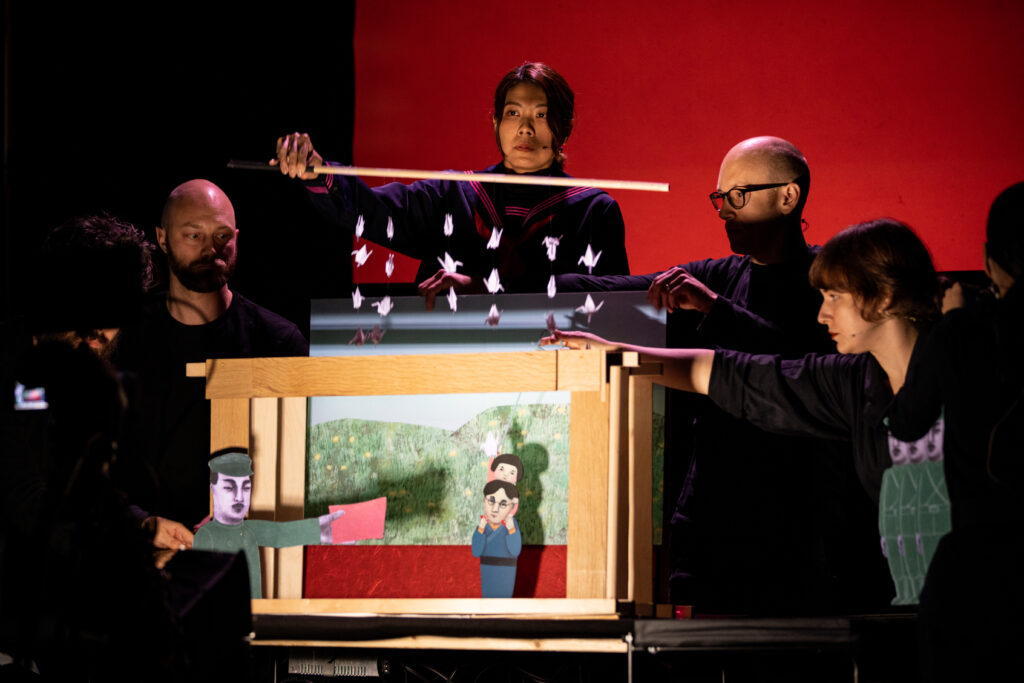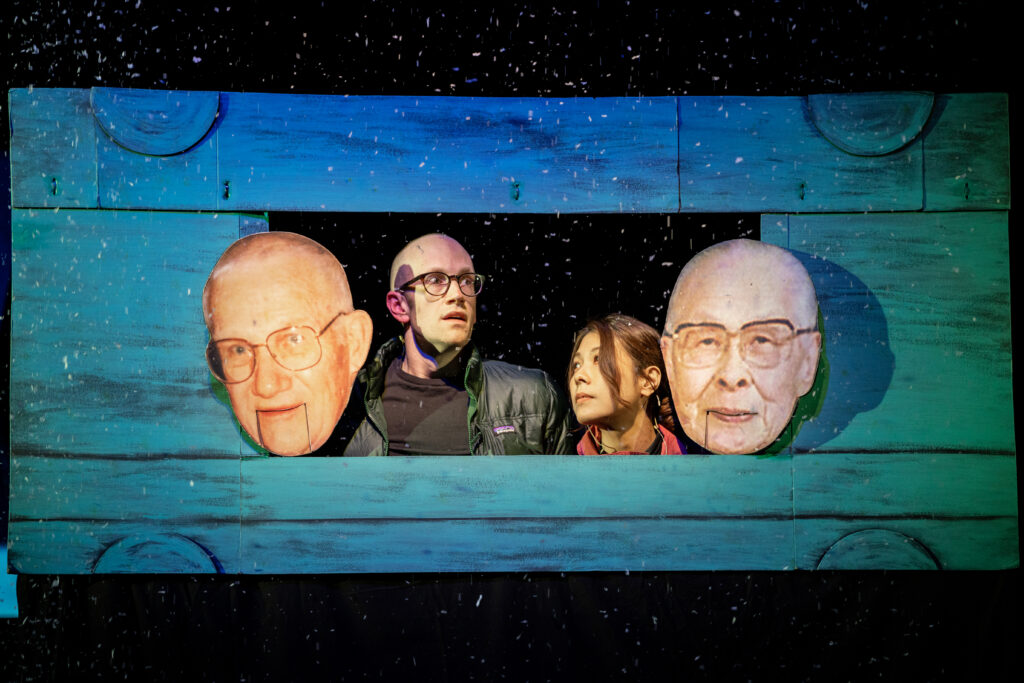9000 Paper Balloons. By Maiko Kikuchi and Spencer Lott. Director and Dramaturg Aya Ogawa. Japan Society, New York, New York, Oct. 28-30 2023.
Co-created by Japanese artist Maiko Kikuchi and American puppeteer Spencer Lott, 9000 Paper Balloons, performed at the Japan Society NYC from October 28-30, follows the transpacific journey of a swarm of “Fu-Go” balloons (hydrogen balloon bombs deployed by Japan against the United States near the end of World War II) from their creation in Japan to their destined destruction either during the journey above waves or on US soil. The balloons’ trajectory intertwines with the intergenerational story of two families, one American and one Japanese, with the grandfathers recounting their experience during the war and the grandchildren tracing history in the narratives. Designed as lethal weapons, only one balloon fulfills its purpose and claims the life of a boy in Oregon, creating a limbo space with the explosion where the grandchildren step into the memory of their grandfathers and reflect on their own positionality in their family lineage, world history, and artistic careers. With Kikuchi’s uniquely surreal design style and an intricate blending of live puppetry and multimedia projection, 9000 Paper Balloons is a poetic commentary on the theme of loss and remembrance both in families and within the larger landscapes of war and history.
The performance strings together its somber reflections with ever-present attention to the major material of its (over one hundred) puppets: paper. Historically, the Fu-Go balloons were made from layers of washi, traditional handmade Japanese paper, which were glued together by thousands of schoolgirls across the country (Coen 2014, 26-27). The performance recreates the balloons as fist-sized rod and string puppets with the same material, grounding the weight of history in the feather-light orbs. It also recreates the process of making the balloons—of the girls’ hands laminating, cutting, and piecing together the papers. As a pair of paper-made hands of a puppet girl works on layers of paper fixed onto the frame in front of her, the paper exists both as the component of balloon bombs (a signifying element within the frame of the story) and the material that makes the show itself. The repeated labor of the puppet hands references the labor that gives form to the puppets, blurring the line between the sign system of puppetry and its real-life materiality. It thus transforms the audience’s perception of this mundane and insignificant material into one layered with historical connotations and mixed feelings—feelings for the girls in history who participated in a war not of their making, the father that the puppet girl loses to the war in the story, and the one innocent life that this delicately crafted and seemingly fragile paper balloon took.

Echoing the paper balloon is an origami (paper folding) crane. Like the papers that make the balloons, the crane goes on a journey of multi-layered materiality and metamorphosis. First appearing as a paper crane placed at the memorial of the balloon’s single lethal attack in Oregon by a girl (played by Maiko wearing an exaggeratedly cartoonish full-head paper mask), the crane serves as a mere prop that carries the girl’s sympathy and condolence for the dead boy. Later, in the limbo space where the grandfathers ride a train, the crane becomes animated with a stick, transforming into a puppet bird that valiantly flaps its wings against the cold wind, shouts, and chases after the train. After the grandfather hears its call and opens the window to catch it, he flattens it, returning a “living, breathing” puppet to a single piece of paper bearing a letter from the grandchild. The crane’s transformation from a static prop to a lively puppet and then to its most basic material form bridges the distance between the snow-covered woodland of Oregon, the limbo land of the ancestral past, and the future land of the grandchildren. It condenses, into a single object, the mechanisms of puppet theatre.
The paper crane draws the audience’s attention, not only to the materiality of the paper that underpins the entire theme of the show, but also to the parallel between the 9000 paper balloons and the story of the 1000 origami cranes. The origami crane’s symbolism of hope and peace in Japanese culture originates from the story of a little Japanese girl, Sasaki Sadako, who was exposed to radiation of the atomic bomb dropped on Hiroshima during World War II and wanted to fold 1000 paper cranes to wish for a healthy life. The popular version of her story is that she died before finishing her project but was buried with 1000 paper cranes as a tribute. Although the creators of the show did not make explicit commentary on the parallel of the Fu-Go project and the Hiroshima bombing, the material correspondence between the paper bomb and paper crane gives the audience a glimpse of a complex history of wartime antagonism and the post-war coexistence of the two nations.
Previously presented as a pre-recorded video, 9000 Paper Balloons‘ live performance at the Japan Society unwraps a rich intermediality that adds greatly to the charm of the show. Sitting in the auditorium at the Japan Society, the show’s audience watched essentially two performances simultaneously: the actual performance by the puppets and puppeteers—mostly on the tabletop at center stage against a backdrop of animation on a big screen—and the live-streaming video of the performance, captured and framed instantaneously by two mobile cameras and played on two screens on the left and right side of the animation backdrop. While the previous audience of the pre-recorded version watched an intricately choreographed and meticulously trimmed “final product,” the live audience got to see, alongside the framed video, the process of making puppet theatre in real time—of performers rushing back and forth to refocus the cameras, shoving used sets away before fishing out new puppets, and all the “out-of-frame” moments demonstrating how the puppeteers animated plain objects into lively puppet performers that actively engaged with the cameras to redefine time and space. In a sense, the bond between the live performance and the recording is also origami: the video—the exquisite crane—unfolds itself in the live performance, exposing its seams and creases and expanding with layers of coordinated movements, spatial correlations, and meticulously timed rhythms to break through the confinements of the flat screen. The unfolding filled the entire stage with puppetry magic.

The creative team takes advantage of the live performance’s ability to break through the frame of the screen to send emotional shock waves to the audience. One such “out-of-frame” moment occurs when the boy is blown up by the bomb. While the screens black out, the boy, in the form of a small puppet held in the puppeteer’s hand, “flies” in slow motion across the stage, his parabola punctuated by sudden beams of spotlight at the left, center, and right of the stage. Silence reigned in the auditorium during the prolonged moments of the boy’s tragic fall. Even though the “boy” is a puppet rather than a real-life actor, its mere material presence in that space and time carried more emotional and historical weight than a flattened image on the screen—it somehow made the fall “more real.” The audience could not help but be saddened as they watched its frail little body twist, float, and “die.” The puppet’s out-of-frame performance of death breaks down the wall between the fictional narrative contained within the video and the real world beyond, forcing the audience to empathize with the character’s suffering and introspect about the aftermath of the war.
Maiko Kikuchi and Spencer Lott’s 9000 Paper Balloons is a feast of puppetry in collaboration with multimedia technology. The dazzling high-tech elements do not distract the creators or the audience from the show’s unwavering attention to its essential materiality and the connotations of fragility, destruction, and transformation inherent in the paper. The show’s commitment to its material origin enables it to tell a story of loss and remembrance that combines the grand narrative of international relations with the intimately personal narratives of family histories. On that basis, the interweaving of live video and performance adds layers of captivating visuals and rich emotions. Like the balloon and the crane, the show stands as a testament to the artistry and craftsmanship of puppetry and theatre-making.
Zhixuan Zhu
Graduate Center, City University of New York
Reference
Coen, Ross. 2014. Fu-Go: The Curious History of Japan’s Balloon Bomb Attack on America. Lincoln: University of Nebraska Press.

